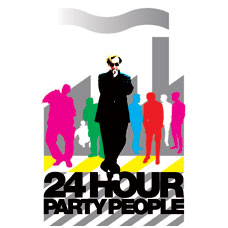
The film '24 hour party people', made in 2002 but set around the 1970's until the 1990's, when 'Acid House' and ecstasy were at their peak reflects a time when it was bands such as the Happy Mondays that indirectly promoted these drugs to the youth market. Sarah Thornton states;'As a result, 'moral panic' has become a routine way of marketing popular music to youth.' (Sarah Thornton, Club Culture: Music, Media and Subculture Capital, 1995: 120)This theory can be applied to drug culture, as the music surrounding the rave scene was marketed due to the moral panics associated with their drug taking. But at the same time the youth who admired and followed the bands of this time could be persuaded to partake in their counterpart's activities.The film is set around the Manchester music scene, and although is one of distinct precedence now, at the time similar events could be seen though- out the country. The film is focused on the music but it also gives us an in-depth look into the lifestyles of some of the icons of the time (and some which have transgressed into present day icons) demonstrating how the youth of those decades could contract similar habits, and make rave and drug culture thrive.Mark 'Bez' Berry, an integral figure who can possibly lay claim to the reason the Happy Monday's success skyrocketed, is portrayed in the film as the drug ambassador, when the band is casually relaxing around a bar, he says, 'Can I offer anyone the best drug experience they've ever had?', Steve Coogans narration describes him as the chemist, with his favourite chemical being Ecstasy.An extract from an interview with the Happy Mondays in November 1988 serves to reinforce this image of the band and the youth market to which they appealed. Shaun Ryder says, tongue firmly in cheek;'Happy Mondays have a reputation as a drugs band. It's a subject to broach carefully, but it has to be brought up. "I don't take drugs. I'm totally against self-abuse of any kind. I don't even smoke ciggies." Shaun sits back. There's a moments silence and then the rest of the band collapse into fits of laughter.' (Stuart Maconie, NME Magazine Interview with the Happy Mondays, 19th November 1988:16)The band were the heroes of the young generation at the time, they wanted to follow their example and imitate their role models. This contributed to a surge in ecstasy in the late 1980's.Although the film '24 Hour Party People' does not demonstrate to us a specific fear of moral panic surrounding ecstasy, it is a prominent subplot through-out the film, so much so that the tagline shown on promotion artwork nationwide was 'Share the Ecstasy', a double entendre for sharing the excitement around the music scene of the time, but also sharing the drug that was in widespread use. The film is a firm basis for any understanding of society in that era when ecstasy really began to influx into the streets and clubs of Britain.A later scene in the film shows us that ecstasy however rife through the Hacienda was a mere stepping stone onto other more extreme moral panics that lay ahead. The scene depicts images of the Hacienda nightclub, ecstasy and drug dealers with plenty of money made from selling drugs to the population of the 'Madchester' scene, the narration, again by Steve Coogan (playing Tony Wilson-head of Factory Records and emissary of the movement) talks the audience through the vicious circle of the unknowing contributors to the demise of the Hacienda. Drug dealers would push ecstasy through-out many club nights and gigs at the Hacienda, consequently meaning that the users would not be purchasing alcoholic drinks from the bar, and so Factory lost out. The drug dealers were the ones to benefit from the club goers seemingly insatiable thirst for ecstasy and came back week upon week with more drugs and eventually brought gun crime inside the Hacienda doors. This then inevitably led to the closure of the nightclub, after a fatal shooting and too many near misses, setting in motion much negative publicity surrounding the youth market and their particular habits of the weekend. This growing wave of public opinion pushed further the closure of the Hacienda, stripping the youth of Manchester and many neighbouring areas of their escapism from the suppressive government and will enforcers.The government's public image at this time was at an all time low, particularly among the youth who saw Thatcherites as trying to stifle their weekend activities. An extract from an article in the Guardian newspaper on January 16th 2004 demonstrates this;'Then, in 1988, during what became known as the second summer of love, ecstasy seemed to have found its spiritual home in a flagging Thatcher's Britain. The nation's youngsters began to congregate in their thousands in fields and warehouses. In acid house they had their music, in fluorescent T-shirts and smileys they had their fashion, and in ecstasy, at L25 a pill, they had their drug.' (http://www.guardian.co.uk/g2/story/0,3604,1124163,00.html Accessed 08/12/2007)The reference in this extract to a flagging Thatcher's Britain is poignant to the historical context due to the youth reveling in the seeming demise of the country under the iron grip of the Iron Lady. The economy was in crisis and government institutions were being sold off contributing to the low moral of society, however through-out times of despair the youth seemed to thrive. They were past feelings of negativity and had moved on into a phase of euphoria fueled by ecstasy. MDMA has been produced since around 1914, and coming through Britain for just under one hundred years, however it was the summer of 1987 that first saw the widespread use of the drug. It is often referred to as a 'weekend' drug by its advocates because the users will only take ecstasy when out on a Friday or Saturday night, rather than keep it in constant use.
No comments:
Post a Comment